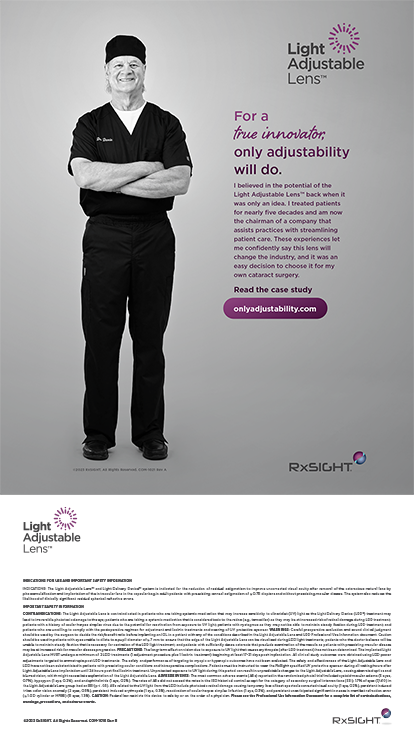For years, the lower-order ocular aberrations of refractive error and regular astigmatism have been corrected with spectacles, contact lenses, corneal refractive surgery, and IOLs. Each modality has its niche in eye care, but knowing the source of ocular astigmatism is critical when considering a toric IOL. Well into the decade of refractive cataract surgery now, accurate IOL power calculations are more important than ever. The formulas used depend on keratometry readings and axial length, and the instrumentation to provide these data is evolving. Although they provide useful data on the anterior surface corneal curvature, keratometry readings or their simulation from corneal topographers (so-called SimKs) fall short when used to estimate total corneal power after refractive surgery. The reason is that the mires of keratometers are apt to fall on the transitional power zone after surgery, leading to errors approaching 1.00 D in power.1 For this reason, the routine use of measures of central corneal power has been promoted (http://iolcalc.org).
A FRESH LOOK AT THE POSTERIOR SURFACE
Regarding the accuracy of astigmatic correction, I would emphasize that the posterior corneal surface is not a silent spherical partner in the measurement of corneal power.2 Rather, it adds a variable measure of cylinder that ranges from 0 to more than 1.00 D in the patient population.3,4 Although an average offset for this astigmatism has been incorporated into a nomogram— an invaluable contribution by Koch et al5— there is a range, which will lead to a certain error in a substantial number of cases.
An accurate determination of corneal power is clearly needed, not just from reflection corneal topographers but from devices that can assess posterior corneal astigmatism as well. Now out of production, the Orbscan was the first widely adopted slit-scanning device capable of measuring posterior corneal astigmatism. 3 Follow-on technology used the Scheimpflug principle to increase depth of field so as to deliver more accurate corneal profiles and measurements of anterior chamber depth and volume. A number of studies have used this technology to refine estimates of posterior corneal astigmatism. Data from these devices can be used to refine estimates of total corneal astigmatism as well as to aid selection of the proper toric IOL.
CAN YOU USE A NOMOGRAM FOR POSTERIOR CORNEAL ASTIGMATISM?
The bull’s eye of expectations among today’s cataract patients is smaller and farther away from the archer (surgeon) than ever before. Patients with significant amounts of cylinder who are candidates for a toric IOL will not be pleased with an over- or undercorrection. Rather than just use the average, surgeons will do better by preoperatively measuring the posterior corneal astigmatism and using that information along with anterior surface astigmatism when selecting the IOL. Many clinics now have Scheimpflug tomographers that can perform these measurements with acceptable repeatability and accuracy.
NEW TECHNOLOGY
Preoperative measurements of total corneal astigmatism cannot prevent all refractive surprises, owing to the contributions of both corneal surfaces. Currently, at least two real-time intraoperative aberrometers are available in the United States. Assuming maintenance of the proper IOP and no contact between the speculum and the globe, measurements of total corneal cylinder taken with these instruments immediately after the lens’ removal will be highly precise, even in eyes that have undergone keratorefractive surgery.6 Then, surgeons can compare the optimal toric IOL indicated by the aberrometer with their preoperative calculations and decide whether or not to refine their lens choice.
There is still a question about the stability of toric IOL correction over time, but unless the lens rotates, the change in correction should be small. This may not be the case for astigmatic corneal incisional corrections, which are subject to wound healing.
WHAT IS IN THE PIPELINE?
The ophthalmic industry seems to have optimized the preoperative accuracy and resolution of Scheimpflug tomographers. A rumor is circulating that a manufacturer of a reflection corneal topographer is developing a method by which to use the second Purkinje image (from the corneal endothelium) to measure posterior corneal astigmatism, as was done with a straightforward approach 2 decades ago.7,8 One of the more unexpected (at least to me) technologies coming to the forefront, however, is the application of swept source optical coherence tomography to accurately measure the tomography of both corneal surfaces.9
As Yogi Berra predicted, “The future lies ahead!” I would add that we are not done yet.
Stephen D. Klyce, PhD, is an adjunct professor of ophthalmology at Mount Sinai School of Medicine in New York. He has served as a consultant to a number of corneal topographer manufacturers, including Abbott Medical Optics, Alcon, Nidek, Oculus Optikgeräte, Tomey, and Topcon Medical Systems. Dr. Klyce may be reached at (516) 324-3069; sklyce@klyce.com.
- Maeda N, Klyce SD, Smolek MK, McDonald MB. Disparity of keratometry readings and corneal power within the pupil after refractive surgery for myopia. Cornea. 1997;16:517-524.
- Ho JD, Tsai CY, Liou SW. Accuracy of corneal astigmatism estimation by neglecting the posterior corneal surface measurement. Am J Ophthalmol. 2009;147:788-795.
- Prisant O, Hoang-Xuan T, Proano C, et al. Vector summation of anterior and posterior corneal topographical astigmatism. J Cataract Refract Surg. 2002;28:1636-643.
- Koch DD, Ali SF, Weikert MP, et al. Contribution of posterior corneal astigmatism to total corneal astigmatism. J Cataract Refract Surg. 2012;38:2080-2087.
- Koch DD, Jenkins RB, Weikert MP, et al. Correcting astigmatism with toric intraocular lenses: effect of posterior corneal astigmatism. J Cataract Refract Surg. 2013;39:1803-1809.
- Ianchulev T, Hoffer KJ, Yoo SH, et al. Intraoperative refractive biometry for predicting intraocular lens power calculation after prior myopic refractive surgery. Ophthalmology. 2014;121:56-60.
- Royston JM, Dunne MCM, Barnes DA. Measurement of posterior corneal surface toricity. Optom Vis Sci. 1990;67:757-763.
- Dunne MCM, Royston JM, Barnes DA. Posterior corneal surface toricity and total corneal astigmatism. Optom Vis Sci. 1991;68:708-710.
- Maeda N. New diagnostic methods for imaging the anterior segment of the eye to enable treatment modalities selection [in Japanese]. Nihon Ganka Gakkai Zasshi. 2011;115:297-322.


